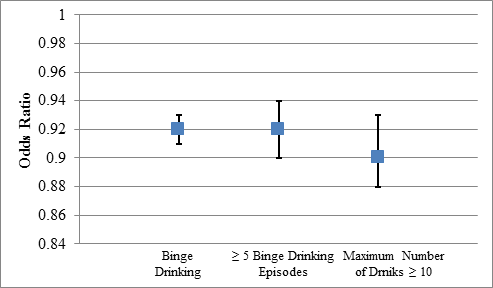Introduction
Policies that restrict access to alcohol have the potential to dissuade risky drinking and related negative consequences. One recent study found US jurisdictions did not increase implementation of the most effective policies from 1999 to 2011. This week, The DRAM explores how alcohol control policies might affect rates of binge drinking (Xuan et al., 2014).
Methods
- Researchers gathered state-level data on the implementation of alcohol control policies through the Alcohol Policy Information System and supplemented with data from 18 additional sources.
- Researchers categorized the policies based on the population and behavior they addressed. Then, experts rated the efficacy and strength of implementation to generate an Alcohol Policy Scale (i.e., APS) score.
- For this study, the authors took the raw APS scores, and converted them so they would fit on a range from 0% to100% of the maximum possible score. For example, a state with a 100% APS score maximally implemented efficacious policies.
- The authors obtained data on state residents’ binge drinking from the Behavioral Risk Factor Surveillance System (BRFSS) survey from 2005-2010.
- Measures included any binge drinking; frequency of binge drinking; and the maximum number of alcoholic drinks consumed during 1 episode in the past month.
- The authors used logistic regression models to examine the odds of individuals in each state binge drinking based on a state’s past-year APS score.
- To strengthen the models, the authors controlled for potential confounders (e.g., gender, age, race/ethnicity).
Figure 1. Odds Ratio and 95% Confidence Interval for the Association Between Binge Drinking and an 10 Point Increase in a State’s Absolute APS Score (Modified from Xuan et al., 2014).
Results
- As Figure 1 shows, an increase of 10 points in the APS score corresponded to an…
- 8% reduction for any binge drinking
- 8% reduction for binge drinking 5 or more times
- 10% reduction for consuming 10 or more drinks within 1 episode during the past month.
Limitations
- The authors could not use data for federal and local policies that might be efficacious for reducing binge drinking.
- As stated in an earlier review of state-level alcohol control policies, the ratings are based on the educated opinions of 10 experts. A different group might rate these policies differently.
- These policies and their rankings might not generalize to other countries.
Conclusion
This study is important because it is the first to measure the association between state-level alcohol control policies and individual level binge drinking behavior. The results are encouraging: when states implemented efficacious policies, their residents were at lower risk for binge drinking. Although much works remains to understand the proper composition of policies that both protect the most people while doing the least amount of harm, this study does provide support to policy makers interested in implementing more effective policies to curb problem drinking and addiction.
— John Kleschinsky
What do you think? Please use the comment link below to provide feedback on this article.
References
Xuan, Ziming, Blanchette, Jason, Nelson, Toben F., Heeren, Timothy, Oussayef, Nadia, & Naimi, Timothy S. (2014). The Alcohol Policy Environment and Policy Subgroups as Predictors of Binge Drinking Measures Among US Adults. American Journal of Public Health, 105(4), 816-822. doi: 10.2105/AJPH.2014.302112





